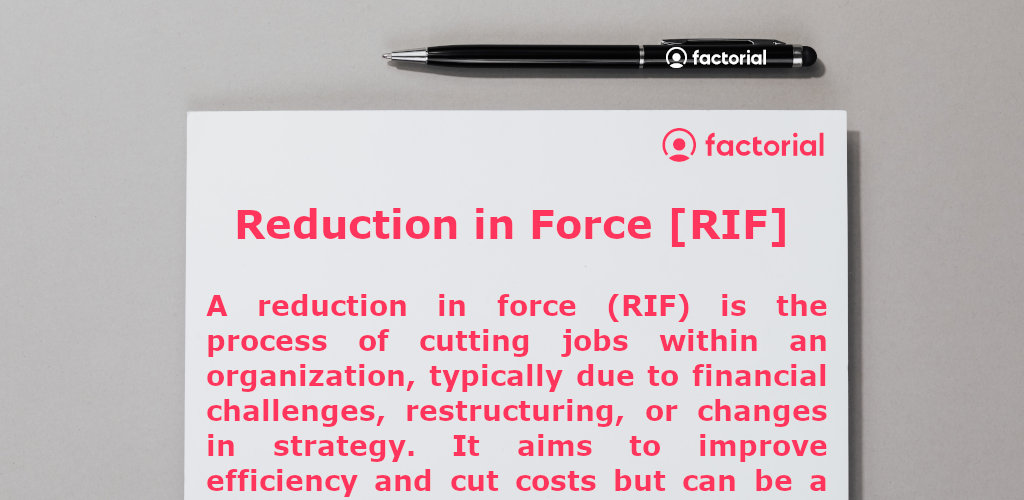In times of economic instability, companies often face the challenging decision of implementing a Reduction in Force (RIF) to stay financially viable. RIFs involve laying off employees or reducing their hours and wages, impacting both individuals and the overall workforce. This article aims to provide a thorough understanding of RIFs, the implications for employers and employees, compliance requirements, strategic approaches, and risk mitigation strategies.
TABLE OF CONTENTS
Reduction in Force (RIF) definition
Employer Considerations
Strategic Approaches to Reduction in Force
Federal Guidelines for Reduction in Force
Impact of RIFs
What RIF means for employees
RIF Compliance Requirements
Tools that help during RIF
Manage employees with HR software ✅
Reduction in Force (RIF) definition
A Reduction in Force (RIF) is a strategic organizational decision to decrease the size of the workforce. Whether prompted by economic conditions, reorganization, or downsizing, RIFs are commonly perceived as a cost-cutting measure. Temporary RIFs affect specific employees for a defined period, usually during economic downturns, while permanent RIFs impact all laid-off employees due to factors such as lack of work, company restructuring, or downsizing.
What employers need to consider during RIF
When contemplating a RIF, employers must assess various factors, including employee morale, retention, productivity, and engagement. A RIF should be approached strategically to minimize adverse effects on the workforce. Legal obligations, as outlined by the Department of Labor (DOL), include providing advance notice of layoffs, offering alternative positions, and considering objective criteria in selection processes.
Strategic Approaches to Reduction in Force (RIF)
To effectively navigate a Reduction in Force (RIF), a strategic approach is essential. This includes:
1. Understanding Legal Obligations
Gaining a comprehensive understanding of legal responsibilities related to RIF is paramount. This involves knowledge of federal, state, and local labor laws that govern the process.
2. Seeking Legal Advice
Consulting with legal experts early in the RIF process is crucial. Legal advice ensures compliance with existing laws and regulations, mitigating potential legal risks, like discrimination.
3. Open Communication with Employees
Transparent communication is a cornerstone of a strategic RIF approach. Keeping employees informed about the reasons, processes, and potential impacts fosters trust and helps manage uncertainty.
4. Developing a Detailed Action Plan
A well-thought-out action plan is essential for a smooth RIF. This plan should outline the timeline, responsibilities, communication strategies, and compliance measures, providing a structured framework for the entire process.
Compliance with labor laws at the federal, state, and local levels is fundamental to the success of a strategic RIF. By incorporating legal expertise early in the planning stages, organizations can ensure a lawful and well-executed reduction in force that aligns with their overall strategic goals.
Outplacement Services
Employers can mitigate the adverse effects of RIFs by offering outplacement services. These services, including career counseling and resume writing, aid employees in finding new employment opportunities. Employers benefit from demonstrating responsibility and assisting affected employees in transitioning to new roles.
Federal Guidelines for Reduction in Force (RIF)
The U.S. Office of Personnel Management (OPM) guides Federal agencies on Reduction in Force (RIF). RIF, outlined in Title 5, Code of Federal Regulations, Part 351, determines employee outcomes when positions are abolished.
Key Considerations:
1. Tenure: Considers employment type (permanent, temporary, or term).
2. Veterans’ Preference: Prioritizes veterans in RIF decisions.
3. Length of Service: Recognizes long-serving employees.
4. Performance Ratings: Considers merit in RIF decisions.
Mandatory Procedures:
Agencies must follow procedures for separation or downgrading due to reorganization, lack of work, or other reasons. Furloughs exceeding 30 calendar days are RIF actions.
OPM Resources:
- Summary of Reduction in Force: Provides RIF procedure overview.
- Employee Guide: Outlines benefits and encourages contact with HR for specifics.
- Transfer of Function: Explores options for employees in transfers.
- Workforce Reshaping Handbook: Assists agencies with mandatory procedures and options to minimize separations.
OPM’s resources offer a comprehensive guide for Federal agencies and employees navigating Reduction in Force processes.
Impact of RIFs
RIFs have far-reaching effects on both individual employees and overall workforce morale. Transparent communication is essential to help employees comprehend the reasons behind the decision and facilitate a smoother transition. Staying compliant with federal laws during a RIF is paramount, as non-compliance can lead to legal repercussions and damage the company’s reputation.
What RIF means for employees
For employees facing a RIF, it means potential job loss or reduced hours, leading to financial and emotional challenges. Understanding legal rights, such as advance notice, severance pay, and unemployment benefits, is crucial. Open communication from employers helps employees navigate the transition more smoothly.
How RIF affects employees
When a company goes through a Reduction in Force (RIF), it affects employees in various ways:
1. Job Changes
Some may lose their jobs due to reasons like reorganization, lack of work, or financial issues. Others might work fewer hours, leading to less income.
2. Money and Feelings
Losing a job or working less can cause financial stress and emotional challenges.
3. Knowing Your Rights
Employees have rights, like getting advance notice, severance pay, and unemployment benefits.
4. Finding New Jobs
Getting a new job can be hard, especially when the job market is uncertain. Employees may need to learn new skills or explore different industries.
5. Feeling Unsure at Work
RIF news can make employees feel uncertain and affect how they see their jobs. Those who stay may face more work and worry about the company’s stability.
6. Understanding Legal Rights
It’s crucial for employees to know their rights during a RIF, including severance terms and how to claim unemployment benefits. Legal advice can help navigate complex laws and protect employee rights.
7. Transition Support
Some companies offer help, like career counseling, to find new job opportunities. Using these resources can make the job transition smoother and improve long-term prospects.
In summary, a Reduction in Force affects employees in many ways—financially, emotionally, and professionally. Knowing rights, seeking support, and exploring new career options are vital during these challenging times.
RIF Compliance Requirements
Strict adherence to compliance requirements, such as the Worker Adjustment and Retraining Notification (WARN) Act, is essential. Providing notice, offering severance pay, and considering employees for other positions within the company are integral components of compliance. Nondiscriminatory practices are crucial to avoid violations of the Civil Rights Act of 1964.
Ensuring Compliance During a Reduction in Force (RIF):
A reduction in force (RIF) is a challenging process that impacts both employers and employees. As organizations navigate the difficult decision to reduce their workforce, it is essential to manage legal obligations to mitigate potential liability. Here are key areas of compliance associated with reductions in force:
1. Federal Law (WARN Act)
- Employers covered by the federal Worker Adjustment and Retraining Notification Act (WARN Act) must adhere to reporting and notice obligations.
- The WARN Act mandates providing at least 60 days’ notice to employees and relevant parties before implementing a RIF, such as a mass layoff or plant closing.
💡 Read more about the federal WARN act.
2. State Law (Mini-WARN Acts)
- In states with their own versions of the WARN Act (mini-WARN laws), employers must comply with state-specific requirements.
- State laws may have different thresholds; for example, California’s mini-WARN law applies to employers with 75 or more employees.
💡 See which states have their own WARN act.
3. Wrongful Discharge Claims
- Laying off some employees while retaining others may lead to wrongful discharge claims based on legal theories like disparate impact, disparate treatment, or retaliation.
- Employers must be mindful of potential legal challenges arising from the layoff decisions.
💡 What is disparate treatment and disparate impact?
4. Severance Considerations
- Employers need to assess whether they are legally obligated to provide severance payments or other benefits based on contracts or agreements.
- If not legally required, employers must decide whether to offer severance and determine the amount.
💡 How to terminate an employment contract.
5. Benefits Continuation (COBRA)
- Implementing a RIF requires providing health plan continuation information to employees, as mandated by the Consolidated Omnibus Budget Reconciliation Act (COBRA).
To navigate this complex process while staying compliant, employers should seek legal advice and follow guidelines set by federal and state laws. This approach helps organizations minimize potential liabilities during this challenging period.
Mitigating RIF Risks
Beyond legal compliance, employers can mitigate risks by carefully screening new hires, auditing employee records, providing comprehensive severance packages, and maintaining positive relations with former employees through regular communication.
Post-RIF Assessment
After completing a RIF, employers should review policies, procedures, and documentation, ensuring compliance with local laws. Gathering feedback from laid-off employees through surveys or interviews can provide valuable insights for future improvements. Establishing a plan for filling open positions is crucial for organizational stability.
Tools that help during RIF
While Reductions in Force are challenging for both employers and employees, careful planning, compliance with legal requirements, and strategic approaches can help navigate these difficult situations successfully. Seeking legal counsel, maintaining open communication, and prioritizing employee support are crucial aspects of minimizing the impact of RIFs on both individuals and the organization as a whole.
Factorial, an all-in-one HR software, can help streamline all of these processes. With HR software, you can ensure that your hiring process and employee onboarding run smoothly. Employee documents can be securely kept in a single centralized hub, and e-signing ensures compliance. While employees are with the company, Factorial allows you to create custom surveys to gauge employee satisfaction. When employees leave the company, access to company records and assets can be revoked with a few simple clicks. HR software can handle these tasks and much more. Book a free demo call with a product specialist now to learn how Factorial can support your company.








